click on images to enlarge
LITTLE-KNOWN TABLEWARE ITEMS
ARGYLES
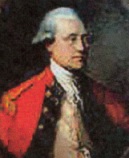  John
Campbell, the fifth Duke of Argyll, and his wife Elizabeth Gunning,
Baroness Hamilton of Hameldon, hated the way that gravy arrived cold
to their table from the kitchens of their Inverary Castle during the
cold Scottish winters. John
Campbell, the fifth Duke of Argyll, and his wife Elizabeth Gunning,
Baroness Hamilton of Hameldon, hated the way that gravy arrived cold
to their table from the kitchens of their Inverary Castle during the
cold Scottish winters.
|
 The
Duke (1723-1806), succeeding his father, the fourth Duke of Argyll
in 1770, was the promoter of a new piece of tableware designed to
maintain the warmth of the gravy in its vessel. This, with a bit of
imagination, was the origin of a warmer called 'argyle' in honour of
the Noble Family that first made a wide use of this device. The
first example was a gravy tureen with spouts fitted on either side
to hold a piece of hot iron, wich maintained the gravy's warmth. The
Duke (1723-1806), succeeding his father, the fourth Duke of Argyll
in 1770, was the promoter of a new piece of tableware designed to
maintain the warmth of the gravy in its vessel. This, with a bit of
imagination, was the origin of a warmer called 'argyle' in honour of
the Noble Family that first made a wide use of this device. The
first example was a gravy tureen with spouts fitted on either side
to hold a piece of hot iron, wich maintained the gravy's warmth.
|
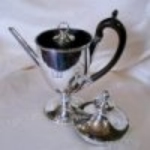 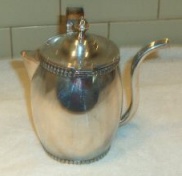
Later, the system was improved upon by the introduction of a jacket
to contain hot water or an internal cylinder into wich a hot iron
was placed. |
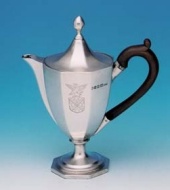  Argyles
were made in a variety of shapes and sizes but most had a rounded
body and a small foot, which maximized the capacity for the gravy or
sauce. Argyles
were made in a variety of shapes and sizes but most had a rounded
body and a small foot, which maximized the capacity for the gravy or
sauce. |
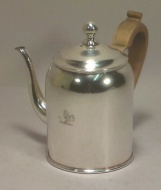 
Usually the spout was placed at the bottom
of the container, which allowed the gravy to be drawn off from
underneath the layer of fat that settled out on the top. |
 Argyles
were produced up until the Victorian period in both silver and
Sheffield plate. They are very rare and only a limited number now
survive, as many of the early examples were later converted into
coffee or tea pots. On the left a Georgian plate coffee pot
abtained, presumably, by a modified argyle Argyles
were produced up until the Victorian period in both silver and
Sheffield plate. They are very rare and only a limited number now
survive, as many of the early examples were later converted into
coffee or tea pots. On the left a Georgian plate coffee pot
abtained, presumably, by a modified argyle
An Argyle of William Grundy
| This argyle
has an exterior jacket for hot water which is poured in through
this lip |
Hallmarks
indicating London manufacture in 1773 by
the English silversmith William Grundy |
| William Grundy's hallmark |
Giorgio Busetto - © 2005 -
www.silvercollection.it
this article is published on  website website
|
|
|




 Argyles
were made in a variety of shapes and sizes but most had a rounded
body and a small foot, which maximized the capacity for the gravy or
sauce.
Argyles
were made in a variety of shapes and sizes but most had a rounded
body and a small foot, which maximized the capacity for the gravy or
sauce.

 Argyles
were produced up until the Victorian period in both silver and
Sheffield plate. They are very rare and only a limited number now
survive, as many of the early examples were later converted into
coffee or tea pots. On the left a Georgian plate coffee pot
abtained, presumably, by a modified argyle
Argyles
were produced up until the Victorian period in both silver and
Sheffield plate. They are very rare and only a limited number now
survive, as many of the early examples were later converted into
coffee or tea pots. On the left a Georgian plate coffee pot
abtained, presumably, by a modified argyle







